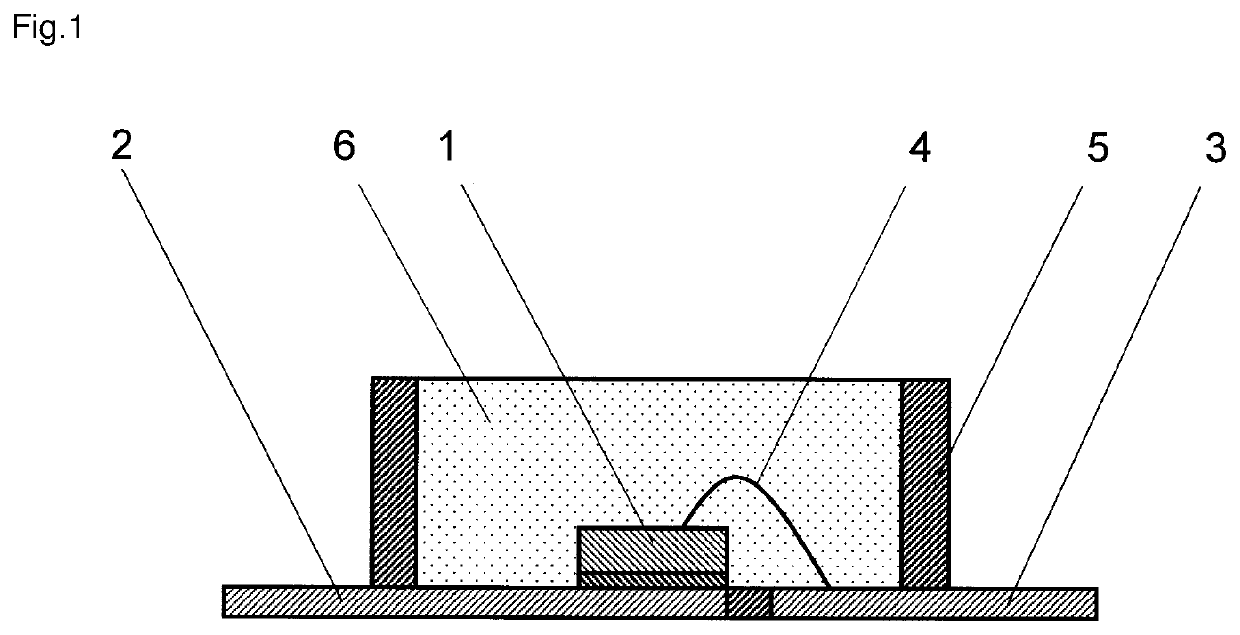Curable silicone composition and optical semiconductor device
a silicone composition and silicone technology, applied in semiconductor devices, semiconductor/solid-state device details, coatings, etc., can solve the problems of contaminating the case, insufficient light extraction efficiency of the light emitting element, color unevenness or chromaticity deviation in the obtained optical semiconductor device, etc., to achieve minimal color unevenness or chromaticity deviation, good light extraction efficiency, and minimal contamination of the case
- Summary
- Abstract
- Description
- Claims
- Application Information
AI Technical Summary
Benefits of technology
Problems solved by technology
Method used
Image
Examples
synthesis example 1
[0076]First, 102.52 g of an organopolysiloxane represented by the formula:
352.53 g of an allyloxy polyalkylene oxide represented by the formula:
CH2═CH—CH2—O—(CH2CH2O)4(CH2CH(CH3)O)18H,
150.0 g of isopropyl alcohol, and 0.1875 g of an isopropyl alcohol solution of a platinum-1,3-divinyl-1,1,3,3-tetramethyldisiloxane complex (platinum content=4 mass %) were charged into a four-neck flask equipped with a stirrer, a reflux condenser, and a thermometer and then heated at 80° C. for 2 hours. Next, 82.7 g of vinyl tris(trimethylsiloxy)silane was charged and heated for 2 hours. Further, 7.2 g of 1-hexene was charged and heated for 2 more hours. After the disappearance of silicon-hydrogen bonds in the reaction mixture was confirmed in the infrared absorption spectrum, the low-boiling-point components were removed to prepare a polyether-modified silicone having a kinematic viscosity of 420 mm2 / s and represented by the formula:
synthesis example 2
[0077]First, 23.46 g of an organopolysiloxane represented by the formula:
57.62 g of an allyloxy polyalkylene oxide represented by the formula:
CH2═CH—CH2—O—(CH2CH2O)4(CH2CH(CH3)O)18H,
50.0 g of toluene, and 0.05 g of an isopropyl alcohol solution of a platinum-1,3-divinyl-1,1,3,3-tetramethyldisiloxane complex (platinum content=4 mass %) were charged into a four-neck flask equipped with a stirrer, a reflux condenser, and a thermometer and then heated at 80° C. for 2 hours. Next, 18.92 g of vinyl tris(trimethylsiloxy)silane was charged and heated for 2 hours. After the disappearance of silicon-hydrogen bonds in the reaction mixture was confirmed in the infrared absorption spectrum, the low-boiling-point components were removed to prepare a polyether-modified silicone having a kinematic viscosity of 520 mm2 / s and represented by the formula:
synthesis example 3
[0078]First, 14.86 g of an organopolysiloxane represented by the average unit formula:
(HMe2SiO1 / 2)0.6(PhSiO3 / 2)0.4,
71.43 g of an allyloxy polyalkylene oxide represented by the formula:
CH═CHCH2O(C2H4O)4(C3H6O)18H,
30.0 g of toluene, and 0.05 g of an isopropyl alcohol solution of a platinum-1,3-divinyl-1,1,3,3-tetramethyldisiloxane complex (platinum content=4 mass %) were charged into a four-neck flask equipped with a stirrer, a reflux condenser, and a thermometer and then heated at 80° C. for 2 hours. Next, 26.07 g of vinyl tris(trimethylsiloxy)silane was charged and heated for 2 hours. After the disappearance of silicon-hydrogen bonds in the reaction mixture was confirmed in the infrared absorption spectrum, the low-boiling-point components were removed to prepare a polyether-modified silicone having a kinematic viscosity of 650 mm2 / s and represented by the average unit formula:
(XMe2SiO1 / 2)0.6(PhSiO3 / 2)0.4
wherein 50 mol % of X is a polyether residue represented by the formula:
—C3H6O...
PUM
| Property | Measurement | Unit |
|---|---|---|
| structure | aaaaa | aaaaa |
| mass ratio | aaaaa | aaaaa |
| wavelength | aaaaa | aaaaa |
Abstract
Description
Claims
Application Information
 Login to View More
Login to View More - R&D
- Intellectual Property
- Life Sciences
- Materials
- Tech Scout
- Unparalleled Data Quality
- Higher Quality Content
- 60% Fewer Hallucinations
Browse by: Latest US Patents, China's latest patents, Technical Efficacy Thesaurus, Application Domain, Technology Topic, Popular Technical Reports.
© 2025 PatSnap. All rights reserved.Legal|Privacy policy|Modern Slavery Act Transparency Statement|Sitemap|About US| Contact US: help@patsnap.com



